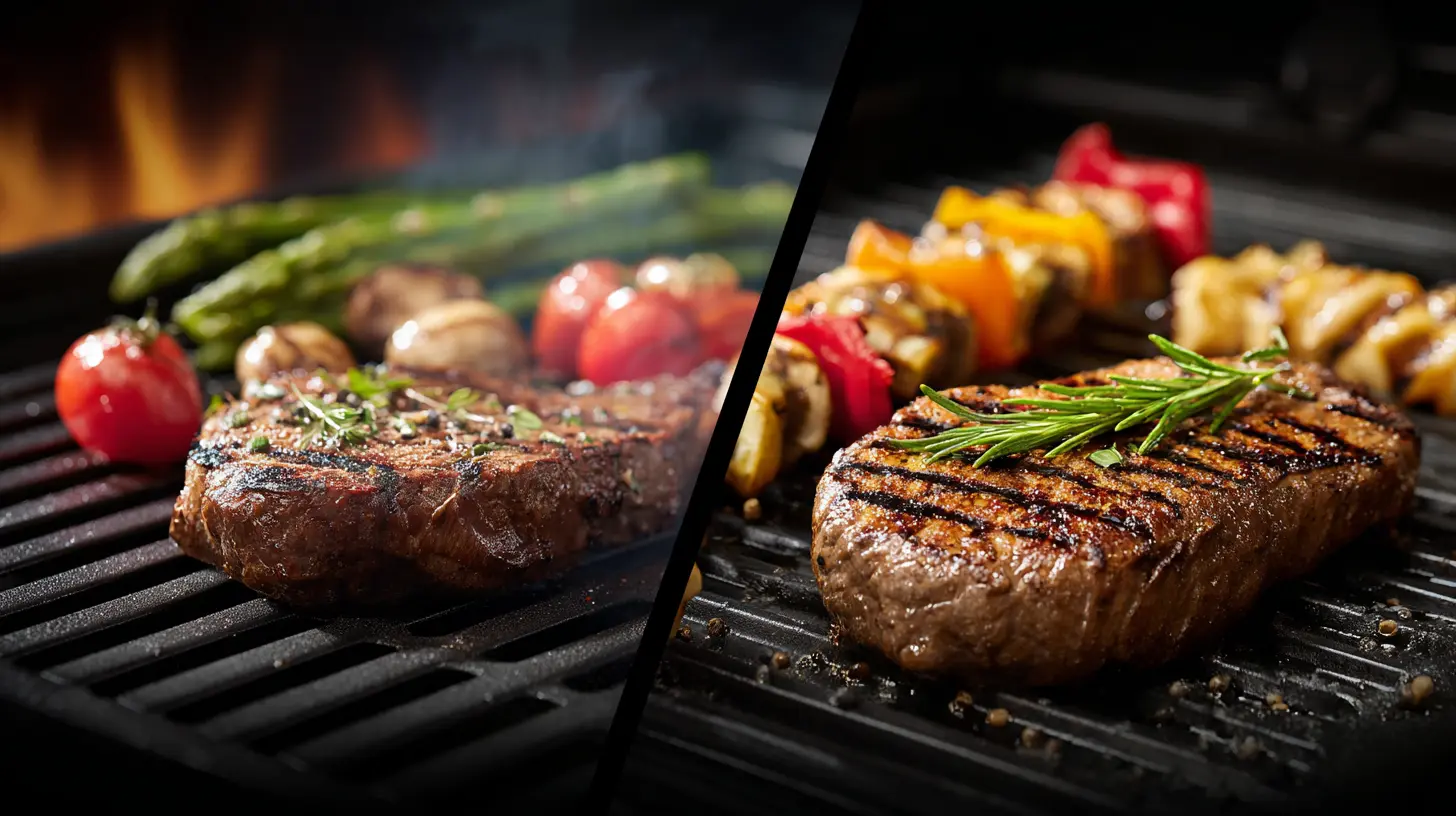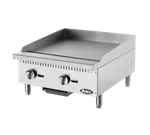
Flat Top vs Griddle vs Grill: When Chefs Use Which (And Why)
- What’s the Difference Between a Flat Top, Griddle, and Grill?
- Flat Top Grill: Hybrid Versatility With Broader Heat Patterns
- Grill: Flavor, Visual Appeal & High Heat
- Flat Top vs Griddle vs Grill: Side-By-Side Comparison
- Menu Applications: Which Surface Should You Choose?
- Heat Performance: The BTU Difference
- Commercial Equipment Considerations for Restaurants
Every professional kitchen relies on high-heat cooking surfaces to deliver speed, consistency, and flavor. Whether you run a diner, steakhouse, hotel kitchen, or food truck, choosing between a flat top, griddle, or grill shapes your entire menu execution. Yet many chefs—even seasoned ones—use these terms interchangeably, despite each piece of equipment performing very differently under pressure.
Understanding the nuances of flat top vs griddle, griddle vs grill, and all the variations chefs search for—like flat top grill vs grill or flat top grill vs griddle—helps you pick the right cooking surface for the food you serve, the volume you handle, and the equipment you plan to invest in.
This guide breaks down how each surface works, which applications it excels at, and what you should consider before choosing a commercial griddle, commercial grill, or hybrid flat-top system.
What’s the Difference Between a Flat Top, Griddle, and Grill?
At first glance, all three pieces of equipment look like heated metal surfaces. But the way they transfer heat—and the foods they prepare best—varies significantly.
Let’s start with the basics.
1. Griddle: The Workhorse of Even Heat
A griddle is a smooth, flat cooking surface typically made of steel or cast iron. It heats evenly across the entire surface, making it incredibly versatile.
Best For:
- Eggs and breakfast items
- Burgers and smashburgers
- Pancakes and French toast
- Deli meats
- Quesadillas
- Fried rice
- Searing seafood or chicken
Chefs choose a griddle when they want uniform surface contact and predictable results. In the discussion about griddle vs grill, the griddle is all about smooth, consistent heat—no grill marks, no flames, just pure flat cooking.
Why Chefs Love Griddles
- Heats evenly (ideal for delicate items)
- Can cook multiple items simultaneously
- Allows precise temperature zone control
- Easy to clean and maintain
When comparing griddle or grill options, most kitchens—even steakhouses—end up needing both. Griddles excel at breakfast, sandwiches, and multitasking.
Flat Top Grill: Hybrid Versatility With Broader Heat Patterns
A flat top grill looks similar to a griddle at first glance, but the key difference is the way it heats. Instead of burners directly beneath a flat plate, it uses radiating heat that creates slight variations across the surface.
This produces a unique cooking experience—not quite a grill, not quite a griddle.
Best For:
- Searing proteins
- Hashes and mixed dishes
- Stir-fry style cooking
- Sauté-like movements
- On-the-fly menu flexibility
When comparing griddle vs flat top, the difference is subtle but important:
- A griddle gives consistent, controlled heat.
- A flat top grill provides a more dynamic heat environment suitable for sautéing, searing, and tossing foods.
Why Chefs Choose Flat Tops
- More flexibility than a strict griddle
- Great for high-volume sautéing
- Better heat zones for complex dishes
- Can be used like multiple pans at once
This is why “flat top vs grill” debates often happen in kitchens that want the searing power of a grill with the versatility of a sauté station.
Grill: Flavor, Visual Appeal & High Heat
A grill uses metal grates heated by gas, charcoal, or wood. Food cooks via radiant heat and direct flame contact, giving signature grill marks and smoky flavor.
Best For:
- Steaks & chops
- Burgers
- Skewers
- Fish steaks
- Vegetables
- BBQ items
When comparing griddle vs grill, grills offer flavors and textures that flat surfaces can’t replicate. The debate of grill vs flat top often comes down to this single question:
Do you want grill marks and smoky flavor?
If yes → Grill.
If not → Flat top or griddle.
Why Chefs Choose Grills
- Distinctive char flavor
- High visual appeal
- Excellent heat penetration
- Great for large proteins
A commercial grill is essential for steakhouses, BBQ joints, food trucks, and fast-casual operations with protein-forward menus.
Flat Top vs Griddle vs Grill: Side-By-Side Comparison
| Feature | Griddle | Flat Top Grill | Grill |
|---|---|---|---|
| Surface | Smooth steel plate | Smooth plate with varied heat zones | Open grates |
| Heat Source | Direct heat under the plate | Radiant heat creating hotter and cooler zones | Direct flame under or around grates |
| Best For | Breakfast items, burgers, pancakes, delicate foods | Searing, sauté-style cooking, mixed dishes, stir-fries | Steaks, chops, burgers, kebabs, charred vegetables |
| Flavor | Neutral, clean browning | Lightly browned, pan-seared style | Smoky, charred flavor with grill marks |
| Skill Level | Easy to learn and operate | Moderate; requires heat zone awareness | Higher skill; managing flare-ups and doneness |
| Versatility | High – works for many menu types | Very high – can mimic sauté, pan-fry, and some grill work | Medium – best for proteins and grill-focused items |
| Cleaning | Scrape, degrease, and wipe; relatively easy | Similar to griddle; scrape and wipe the surface | Requires brushing grates and managing char buildup |
This table helps settle many flat top vs griddle and griddle vs grill debates: each serves a distinct culinary purpose.
Menu Applications: Which Surface Should You Choose?
Here's where menu design meets equipment buying decisions.
Choose a Griddle If You Serve:
- All-day breakfast
- Smashburgers
- High-volume brunch
- Fast-casual sandwiches
- Diners or cafés
A commercial griddle is the backbone of many restaurant lines because it fits almost every menu style.
Choose a Grill If You Serve:
- Steaks
- BBQ
- Chops
- Kabobs
- Burgers with grill marks
- Charred vegetables
If the dish needs flame-kissed flavor, a commercial grill is the right tool.
Choose a Flat Top If You Serve:
- Stir-fries
- Fusion menus
- Sear-heavy proteins
- Quick sautéed dishes
- Fast-moving lunch crowds
A flat top grill vs griddle debate often ends with the flat top being the more versatile choice for modern menus.
Heat Performance: The BTU Difference
Understanding heating power is essential for chefs comparing a grill vs flat top or griddle vs grill.
Griddles:
- Typically 20,000–30,000 BTUs per burner
- Direct contact cooking = fast cooking times
Flat Tops:
- Slightly higher BTUs due to heat distribution
- Excellent for high-volume searing
Grills:
- Highest BTUs, often 40,000+
- Needed for thick proteins
When operators search for the best flat top grill, they’re usually seeking strong BTUs paired with even surfacing for consistent searing.
Cleaning & Maintenance Differences
Griddles:
- Easiest to clean: scrape → oil → wipe
- Daily seasoning improves performance
Flat Tops:
- Similar maintenance to griddles
- Must manage hot/cool zones carefully
Grills:
- Requires brushing
- Grates must be_oiled before each service
- Char buildup needs regular cleaning
If maintenance time matters, most restaurants prefer a commercial griddle or flat top over a grill.
Commercial Equipment Considerations for Restaurants
When choosing between a commercial grill, commercial griddle, or flat top system, consider:
- Menu mix
- Kitchen space
- Ventilation system
- Fuel type (gas, propane, electric)
- Volume requirements
- Staff skill level
Many kitchens end up buying two of the three:
- A commercial griddle for versatility
- A grill for signature items
- A flat-top accessory or combi-unit for flexibility
Some manufacturers even make hybrid surfaces combining zones of each style.
Final Thoughts: Which One Should Your Kitchen Choose?
Choosing between a flat top vs griddle, griddle vs grill, or grill vs flat top depends entirely on what kind of food you want to serve—and how fast you need to serve it.
- Go with a griddle if you need consistency and volume.
- Choose a grill if flavor and presentation matter most.
- Select a flat top grill if you want a hybrid tool that gives you flexibility across cuisines.
The right equipment unlocks speed, precision, and better flavor execution—making it one of the most important investments for any chef or operator.





